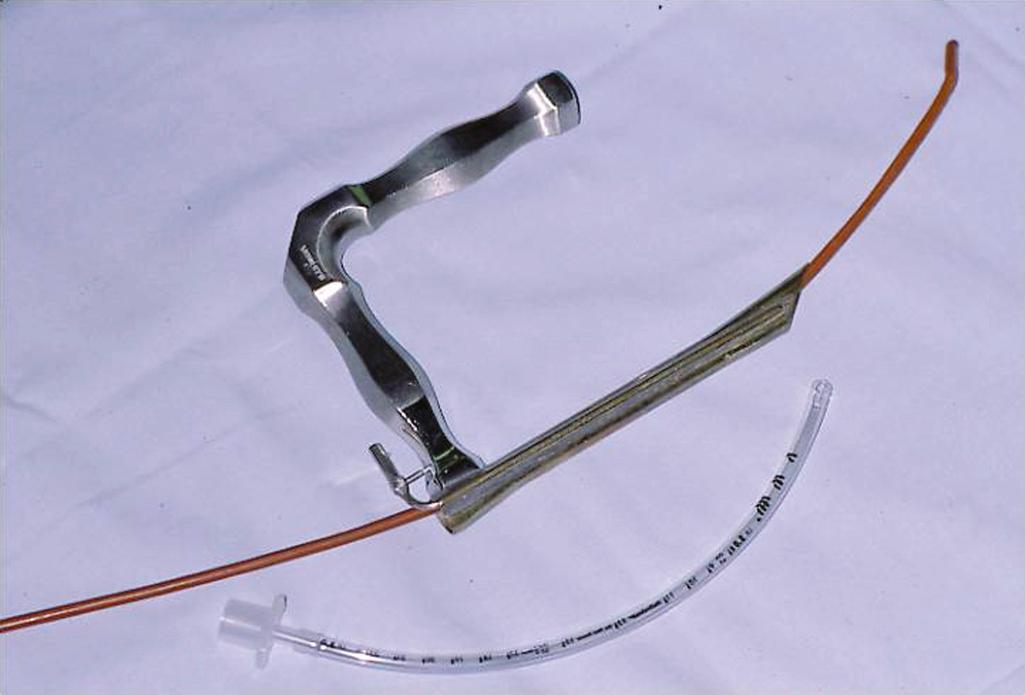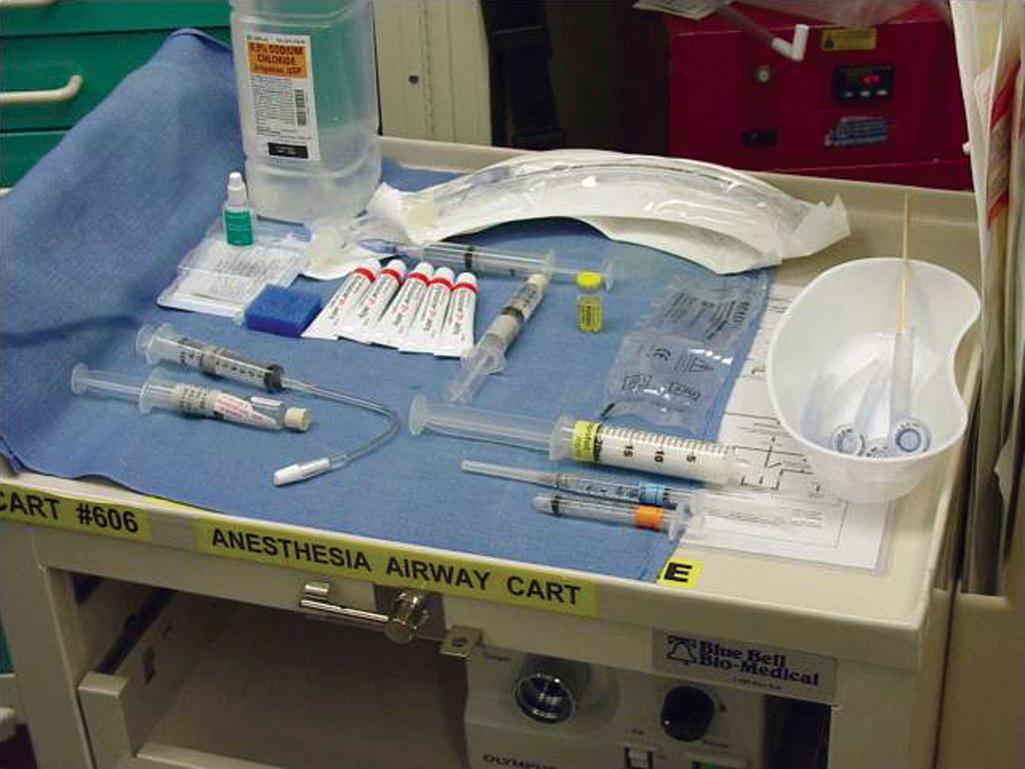Physical Address
304 North Cardinal St.
Dorchester Center, MA 02124
The difficult airway involves a difficult mask ventilation and/or a difficult tracheal intubation.
Identification of a difficult airway, whenever possible, is vital prior to manipulation.
An essential member of the difficult airway response team is an otolaryngologist with training and expertise in endoscopic techniques such as rigid/flexible laryngoscopy, bronchoscopy, and the ability to provide open surgical access of the airway.
Techniques commonly used in management of the difficult airway include obtaining a surgical airway or intubation through either awake fiberoptic laryngoscopy, a laryngeal mask airway (LMA), direct laryngoscopy with an anterior commissure laryngoscope, or laryngoscopy using a videolaryngoscope.
Insufficient experience in fiberoptic laryngoscopy and bronchoscopy is a common cause of failure in awake fiberoptic intubation.
Once a “cannot intubate, cannot ventilate” situation has been identified, immediate consideration should be given to providing surgical airway access.
Difficulties with intubation and emergent airway issues remain a leading cause of serious intraoperative complications. As many as 25% of deaths attributable to anesthesia involve failure to manage the difficult airway. In any given patient, the risk of anoxic injury or death increases in direct proportion to the degree of difficulty in maintaining a patent airway.
A patient should be considered to have a difficult airway if the medical provider experiences significant difficulty with either ventilation or intubation. A patient is considered a difficult tracheal intubation when multiple attempts are needed to establish an airway. Although clinical circumstances may make an intubation difficult, to be labeled a difficult airway these failed attempts should occur in optimal settings. This means the trachea could not be intubated within two attempts under direct vision despite full paralysis, optimal head and neck positioning, forceful anterior elevation of the laryngoscope blade, and attempts with a variety of laryngoscope blades. The incidence of intubation failure in elective cases is approximately 0.1% ; however, the likelihood of success is highly situation dependent. As evidence of this, the rate of intubation failure increases to more than 1% in the emergency room setting.
Another difficult airway scenario is the difficult laryngoscopy, described as the inability to visualize any portion of the vocal folds after multiple attempts at conventional laryngoscopy. This includes Grades III and IV according to the Cormack-Lehane original grading of the rigid laryngoscopic view. The technical components that optimize laryngoscopy include proper head position, complete muscle relaxation, firm forward and upward traction on the laryngoscope, and, if necessary, firm external laryngeal manipulation with cricoid pressure. External laryngeal pressure, for example, may reduce the incidence of a Grade III view from 9% to 1.3%.
The difficult airway scenario that is often the most serious is the difficult mask ventilation (DMV), a condition in which it is not possible to provide adequate facemask ventilation. This may be the result of inadequate mask seal or excessive resistance due to inadequate patency of the airway. The DIFFICAIR study found that patients were difficult to ventilate with a mask approximately 1% of the time. Other studies showed similar rates of bag-mask ventilation (BMV) failure ranging from 0.6% to 5%. However, when a DMV patient is also found to be difficult to expose adequately at laryngoscopy, the situation can be described as “cannot intubate, cannot ventilate” and becomes an emergency. In such a situation, a surgical airway should be strongly considered. A patient who can be ventilated by bag mask but cannot be intubated is not an emergency. It is essential to remember this important tenet because repeated failed attempts to intubate can precipitate the inability to ventilate with a bag mask owing to laryngeal trauma, thus turning a stable situation into an emergency. Patient factors that have been found to be associated with difficulty ventilating and intubating include the following: a Mallampati score of III/IV, neck radiation or mass, male sex, limited thyromental distance, body mass index (BMI) greater than 30, age greater than 46 years, presence of a beard, a thick neck, sleep apnea, limitation of neck extension, or limited jaw protrusion. A strong correlation has also been found between DMV and having difficulty intubating.
The identification of a difficult airway before manipulation is extremely helpful, but such problems are very difficult to predict. The most important piece of information in this regard is a history of prior intubations, specifically the documentation of prior attempts. Selection of specific airway equipment and planned procedures all depend on the airway evaluation. Communication of the airway management plan with other members of the team is arguably the most important step when the difficult airway must be dealt with. Contingency plans should also be discussed and understood by the team. The otolaryngologist is often designated as the leader of the team in these situations. As the team leader, it is of the utmost importance for this individual to exude a calm confidence regardless of what he or she may feel internally. Fear is contagious, and the other members of the team will not be able to help if everyone begins to panic. Yelling should be avoided and clear communication maintained.
When management options for the difficult airway are being considered, the anesthesiologist and surgeon must give consideration to aborting the planned procedure, waking the patient, and reassessing airway management options before proceeding. The team leader must also consider alternative techniques, such as video-assisted laryngoscopy, placement of an LMA, intubation via awake fiberoptic laryngoscopy, or the use of an anterior commissure laryngoscope.
In the difficult airway, an LMA may be used as a temporizing measure until the patient is awakened or for the duration of the procedure. With advances in equipment design, intubating LMAs or similar supraglottic airway devices (SADs) are now available. Intubation can be accomplished by passing the endotracheal tube (ETT) through the LMA or SAD (blind technique) or may be done more safely by passing it over a fiberoptic bronchoscope. The LMA or SAD may be removed while securing the ETT within the airway using an intubation exchange catheter or a stabilizing rod.
The anterior commissure laryngoscope is arguably the otolaryngologist's most useful tool in the management of a difficult airway and should always be considered. This is a particularly useful piece of equipment to have set up prior to an attempted intubation for a patient known to have a difficult airway. However, the anterior commissure laryngoscope will accommodate only a small ETT (5.5 or less). If a larger ETT is required, a tracheal tube introducer should first be inserted into the airway through the laryngoscope, followed by removal of the laryngoscope and then insertion of the ETT over the introducer (intubation bougie) ( Fig. 6.1 ).

One of the safest ways to manage a difficult airway is to perform an awake fiberoptic intubation. The otolaryngologist is frequently more comfortable with this technique than the anesthesiologist or intensivist, especially with the increased use of video-assisted laryngoscopy. This procedure is discussed in detail in the following sections.
Surgical procedures such as open cricothyroidotomy, tracheostomy, and transtracheal jet ventilation should be considered during a “cannot ventilate, cannot intubate” situation. The role an otolaryngologist can play in such situations is critical. The indications, contraindications, techniques, and strategies to optimize success with these techniques are discussed in detail later.
Flexible fiberoptic technology has provided the vehicle for developing and perfecting these intubation techniques. A flexible fiberoptic choledochoscope was first used for nasotracheal intubation on a patient with Stills disease as early as 1967. Five years later, nasotracheal intubation was successfully carried out in a patient with severe rheumatoid arthritis using a fiberoptic bronchoscope. Stiles and colleagues subsequently reported the first series of 100 fiberoptic endotracheal intubations.
Fiberoptic bronchoscopy was not originally developed for intubation or the management of the difficult intubation ; however, as technology advanced and visualization improved, anesthesiologists soon appreciated its value in the management of the difficult airway.
When a difficult airway is anticipated, awake fiberoptic intubation (FOI) with or without sedation should be considered ( Box 6.1 ). Awake FOI is often an ideal procedure for producing an airway of adequate size and dealing with other medical conditions that make visualization of the glottis difficult, such as marked obesity, a supraglottic/glottic mass, supraglottic/glottic edema, or trismus. Visualization of the glottis is necessary for successful FOI. Contraindications to awake FOI include fixed stenotic lesions at all levels that will not allow passage of an ETT without dilation, significant bleeding that obscures visualization, and patients who are unable to cooperate during the examination. In general, many patients who might be denied general anesthesia or who might receive a tracheostomy can be safely intubated using awake FOI. However, to intubate patients safely and quickly, certain preparatory steps must be taken.
Difficult intubation
Known or anticipated
Unanticipated failed intubation
Compromised airway
Upper airway
Lower airway (tracheal compression)
Intubation of the conscious patient preferred
High risk of aspiration
Movement of neck not desirable
Known difficult mask ventilation
Morbid obesity
Self-positioning
High risk of dental damage
A fully equipped videobronchoscopy cart should be available for use in any intensive care unit (ICU), emergency department, critical care ward, and operating room (OR). All equipment and supplies for the administration of anesthesia, resuscitation, and monitoring should be checked before beginning a nonemergent FOI ( Fig. 6.2 ). For awake intubations, the cart is placed on the patient's left at the head of the bed and the operator stands on the patient's right. The cart should contain ancillary equipment including a nasopharyngeal airway and ETTs (standard and long microlaryngoscopy tubes) among other items.

Become a Clinical Tree membership for Full access and enjoy Unlimited articles
If you are a member. Log in here